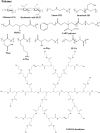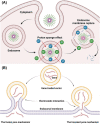Recent Progress in Nucleic Acid Pulmonary Delivery toward Overcoming Physiological Barriers and Improving Transfection Efficiency
- PMID: 38460157
- PMCID: PMC11095210
- DOI: 10.1002/advs.202309748
Recent Progress in Nucleic Acid Pulmonary Delivery toward Overcoming Physiological Barriers and Improving Transfection Efficiency
Abstract
Pulmonary delivery of therapeutic agents has been considered the desirable administration route for local lung disease treatment. As the latest generation of therapeutic agents, nucleic acid has been gradually developed as gene therapy for local diseases such as asthma, chronic obstructive pulmonary diseases, and lung fibrosis. The features of nucleic acid, specific physiological structure, and pathophysiological barriers of the respiratory tract have strongly affected the delivery efficiency and pulmonary bioavailability of nucleic acid, directly related to the treatment outcomes. The development of pharmaceutics and material science provides the potential for highly effective pulmonary medicine delivery. In this review, the key factors and barriers are first introduced that affect the pulmonary delivery and bioavailability of nucleic acids. The advanced inhaled materials for nucleic acid delivery are further summarized. The recent progress of platform designs for improving the pulmonary delivery efficiency of nucleic acids and their therapeutic outcomes have been systematically analyzed, with the application and the perspectives of advanced vectors for pulmonary gene delivery.
Keywords: delivery vectors; inhaled materials; nucleic acids; pulmonary bioavailability; pulmonary delivery.
© 2024 The Authors. Advanced Science published by Wiley‐VCH GmbH.
Conflict of interest statement
The authors declare no conflict of interest.
Figures









Similar articles
-
Utilizing ionic liquids as eco-friendly and sustainable carriers for delivering nucleic acids: A review on the revolutionary advancement in nano delivery systems.Int J Biol Macromol. 2024 Dec;283(Pt 2):137582. doi: 10.1016/j.ijbiomac.2024.137582. Epub 2024 Nov 13. Int J Biol Macromol. 2024. PMID: 39542300 Review.
-
Qualitative evidence synthesis informing our understanding of people's perceptions and experiences of targeted digital communication.Cochrane Database Syst Rev. 2019 Oct 23;10(10):ED000141. doi: 10.1002/14651858.ED000141. Cochrane Database Syst Rev. 2019. PMID: 31643081 Free PMC article.
-
Medications for chronic obstructive pulmonary disease: a historical non-interventional cohort study with validation against RCT results.Health Technol Assess. 2021 Aug;25(51):1-70. doi: 10.3310/hta25510. Health Technol Assess. 2021. PMID: 34463610 Clinical Trial.
-
Trends in Surgical and Nonsurgical Aesthetic Procedures: A 14-Year Analysis of the International Society of Aesthetic Plastic Surgery-ISAPS.Aesthetic Plast Surg. 2024 Oct;48(20):4217-4227. doi: 10.1007/s00266-024-04260-2. Epub 2024 Aug 5. Aesthetic Plast Surg. 2024. PMID: 39103642 Review.
-
Advanced approaches to overcome biological barriers in respiratory and systemic routes of administration for enhanced nucleic acid delivery to the lung.Expert Opin Drug Deliv. 2023 Jul-Dec;20(11):1531-1552. doi: 10.1080/17425247.2023.2282535. Epub 2023 Dec 20. Expert Opin Drug Deliv. 2023. PMID: 37946533 Free PMC article. Review.
References
-
- Chang R. Y. K., Chow M. Y. T., Khanal D., Chen D., Chan H., Adv. Drug Delivery Rev. 2021, 172, 64. - PubMed
-
- Kaczmarek J. C., Patel A. K., Rhym L. H., Palmiero U. C., Bhat B., Heartlein M. W., DeRosa F., Anderson D. G., Biomaterials 2021, 275, 120966. - PubMed
-
- Abed S., Turner R., Serniuck N., Tat V., Naiel S., Hayat A., Mekhael O., Vierhout M., Ask K., Rullo A. F., Biochem. Pharmacol. 2021, 190, 114577. - PubMed
Publication types
MeSH terms
Grants and funding
- BK20220102/Natural Science Foundation of Jiangsu Province-Outstanding Youth Foundation
- 23KJB350003/Natural Science Foundation of the Jiangsu Higher Education Institutions of China
- PPE2023002/Project of NMPA Key Laboratory for Research and Evaluation of Pharmaceutical Preparation and Excipients
- JSSCRC2021569/Jiangsu Province Innovation and Entrepreneurship Program
- BK20230316/Natural Science Foundation of Jiangsu Province
LinkOut - more resources
Full Text Sources
Medical
Research Materials
